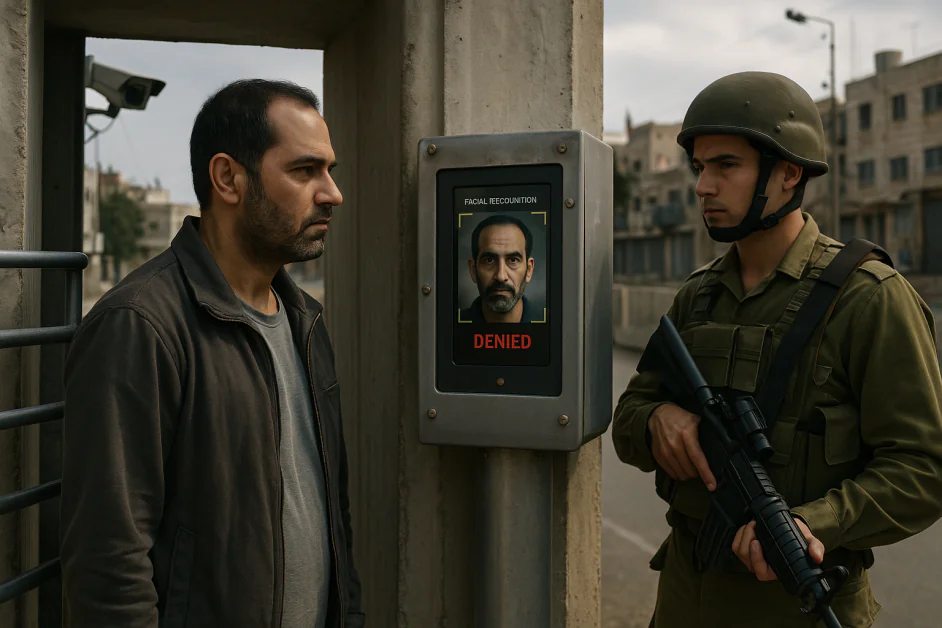Surveillance
Red Wolf, Blue Wolf: AI-Powered Facial Recognition and the Surveillance of Palestinians

Few places on Earth are as relentlessly surveilled as the occupied Palestinian territories.
In the streets of Hebron, at crowded checkpoints in East Jerusalem, and in the daily lives of millions, advanced AI systems now act as both gatekeeper and watchman.
Behind the cameras and databases are two chillingly efficient tools — Red Wolf and Blue Wolf — facial recognition systems designed not for convenience or commerce, but for control.
Their job: scan faces, match them against vast biometric databases, and decide whether someone can move freely or must be stopped.
What makes these systems so alarming is not just the technology itself, but the way they are used — targeting an entire population based on ethnicity, collecting data without consent, and embedding algorithms into the machinery of occupation.
In the sections ahead, we explore how these AI systems work, where they’ve been deployed, the abuses they fuel, and why they matter far beyond Palestine.
How Red Wolf and Blue Wolf Operate
Blue Wolf is a mobile application carried by soldiers on patrol. A quick photo of a Palestinian’s face triggers an instant cross-check against a large biometric repository often referred to by troops as Wolf Pack.
The response is brutally simple: a color code. Green suggests pass; yellow means stop and question; red signals detain or deny entry.
Blue Wolf isn’t just a lookup tool. It enrolls new faces. When a photo doesn’t match, the image and metadata can be added to the database, creating or expanding a profile. Units have been encouraged to capture as many faces as possible to “improve” the system.
Red Wolf moves identification to the checkpoint itself. Fixed cameras at turnstiles scan every face that enters the cage. The system compares the facial template to enrolled profiles and flashes the same triage colors on a screen.
If the system doesn’t recognize you, you don’t pass. Your face is then captured and registered for next time.
AI and Machine Learning Under the Hood
Exact vendors and model architectures aren’t public. But the behavior aligns with a standard computer-vision pipeline:
- Detection: Cameras or phone sensors locate a face in the frame.
- Landmarking: Key points (eyes, nose, mouth corners) are mapped to normalize pose and lighting.
- Embedding: A deep neural network converts the face into a compact vector (“faceprint”).
- Matching: That vector is compared against stored embeddings using cosine similarity or a nearest-neighbor search.
- Decisioning: If similarity exceeds a threshold, the profile is returned with a status; otherwise, a new profile may be created.
What’s distinctive here is the population specificity. The training and reference data overwhelmingly comprise Palestinian faces. That concentrates model performance on one group — and codifies a form of digital profiling by design.
At scale, the systems likely employ edge inference for speed (phones and checkpoint units running optimized models) with asynchronous sync to central servers. That minimizes latency at the turnstile while keeping the central database fresh.
Thresholds can be tuned in software. Raising them reduces false positives but increases false negatives; lowering them does the opposite. In a checkpoint context, incentives skew toward over-flagging, shifting the burden of error onto civilians.
Data, Labels, and Drift
Facial recognition is only as “good” as its data.
Blue Wolf’s mass photo collection campaigns act as data acquisition. Faces are captured in varied lighting and angles, with labels attached post-hoc: identity, address, family links, occupation, and a security rating.
Those labels are not ground truth. They’re administrative assertions that can be outdated, biased, or wrong. When such labels feed model retraining, errors harden into features.
Over time, dataset drift creeps in. Children become adults. People change appearance. Scarcity of “hard” examples (similar-looking people, occlusions, masks) can inflate real-world error rates. If monitoring and re-balancing are weak, the system quietly degrades — while retaining the same aura of certainty at the checkpoint.
Where It’s Deployed and How It Scales
Hebron’s H2 sector is the crucible. Dozens of internal checkpoints regulate movement through Old City streets and to Palestinian homes.
Red Wolf is fixed at select turnstiles, creating a compulsory enrollment funnel. Blue Wolf follows on foot, extending coverage to markets, side streets, and private doorsteps.
In East Jerusalem, authorities have layered AI-capable CCTV across Palestinian neighborhoods and around holy sites. Cameras identify and track individuals at distance, enabling post-event arrests by running video through face search.
Surveillance density matters. The more cameras and capture points, the more complete the population graph: who lives where, who visits whom, who attends what. Once established, that graph feeds not just recognition but network analytics and pattern-of-life models.
Hebron: A City Under Digital Lockdown
Residents describe checkpoints that feel less like border crossings and more like automated gates. A red screen can lock someone out of their own street until a human override arrives — if it arrives at all.
Beyond access control, the camera grid saturates daily life. Lenses jut from rooftops and lampposts. Some point into courtyards and windows. People shorten visits, change walking routes, and avoid lingering outside.
The social cost is subtle but pervasive: fewer courtyard gatherings, fewer chance conversations, fewer street games for children. A city becomes quiet not because it’s safe but because it’s watched.
East Jerusalem: Cameras in Every Corner
In East Jerusalem’s Old City and surrounding neighborhoods, facial recognition rides on an expansive CCTV backbone.
Footage is searchable. Faces from a protest can be matched days later. The logic is simple: you may leave today, but you won’t leave the database.
Residents talk about the “second sense” you develop — an awareness of every pole-mounted dome — and the internal censor that comes with it.
The Human Rights Crisis
Several red lines are crossed at once:
- Equality: Only Palestinians are subject to biometric triage at these checkpoints. Separate routes shield settlers from comparable scrutiny.
- Consent: Enrollment is involuntary. Declining to be scanned means declining to move.
- Transparency: People can’t see, contest, or correct the data that governs them.
- Proportionality: A low-friction, always-on biometric dragnet treats an entire population as suspect by default.
Facial recognition also misidentifies — especially with poor lighting, partial occlusion, or age change. In this setting, a false match can mean detention or denial of passage; a missed match can strand someone at a turnstile.
The Psychological Toll
Life under persistent AI surveillance teaches caution.
People avoid gatherings, alter routines, and supervise children more closely. Words are weighed in public. Movement is calculated.
Many describe the dehumanizing effect of being reduced to a green, yellow, or red code. A machine’s binary judgment becomes the most important fact about your day.
Governance, Law, and Accountability
Inside Israel proper, facial recognition has encountered privacy pushback. In the occupied territories, a different legal regime applies, and military orders override civilian privacy norms.
Key gaps:
- No independent oversight with power to audit datasets, thresholds, or error rates.
- No appeals process for individuals wrongly flagged or enrolled.
- Undefined retention and sharing rules for biometric data and derived profiles.
- Purpose creep risk as datasets and tools are repurposed for intelligence targeting and network surveillance.
Without binding limits, the default trajectory is expansion: more cameras, broader watchlists, deeper integrations with other datasets (phones, vehicles, utilities).
Inside the Decision Loop
Facial recognition here doesn’t operate in a vacuum. It’s fused with:
- Watchlists: Lists of names, addresses, and “associates” that steer color-code outcomes.
- Geofencing rules: Locations or time windows that trigger heightened scrutiny.
- Operator UX: Simple color triage that encourages automation bias — human deference to machine output.
- Command dashboards: Heatmaps, alerts, and statistics that can turn “more stops” into “better performance.”
Once command metrics prize volume — more scans, more flags, more “finds” — the system drifts toward maximizing friction for the population it governs.
What Makes It Different From Conventional Surveillance
Three features set Red Wolf/Blue Wolf apart:
- Compulsory capture: Movement often requires scanning. Opt-out equals lock-out.
- Population specificity: The model and database focus on one ethnic group, baking discrimination into the pipeline.
- Operational integration: Outputs instantly gate access and trigger enforcement, not just after-the-fact analysis.
Elements echo other deployments worldwide: dense camera grids, face search on protest footage, predictive policing fed by skewed labels.
But the fusion of military occupation and AI-gated movement is unusually stark. It demonstrates how modern computer vision can harden systems of segregation — making them faster, quieter, and harder to contest.
Security officials argue that these tools prevent violence and make screening more efficient.
Critics counter that “efficient occupation” is not an ethical upgrade. It simply industrializes control — and shifts the cost of error onto civilians who lack any recourse.
What to Watch Next
- Model creep: Expansion from face ID to gait, voice, and behavior analytics.
- Threshold tuning: Policy changes that quietly raise or lower match bars — and civilian burden.
- Data fusion: Linking biometrics to telecom metadata, license-plate readers, payments, and utilities.
- Export: Adoption of similar “battle-tested” systems by other governments, marketed as smart-city or border security solutions.
Conclusion: A Warning for the World
At a Hebron turnstile or a Damascus Gate alley, AI has become a standing decision-maker over human movement.
The danger isn’t the camera alone. It’s the system: compulsory enrollment, opaque databases, instant triage, and a legal vacuum that treats an entire people as permanently suspect.
What’s being normalized is a template — a way to govern through algorithms. The choice facing the wider world is whether to accept that template, or to draw a hard line before automated suspicion becomes the default setting of public life.












